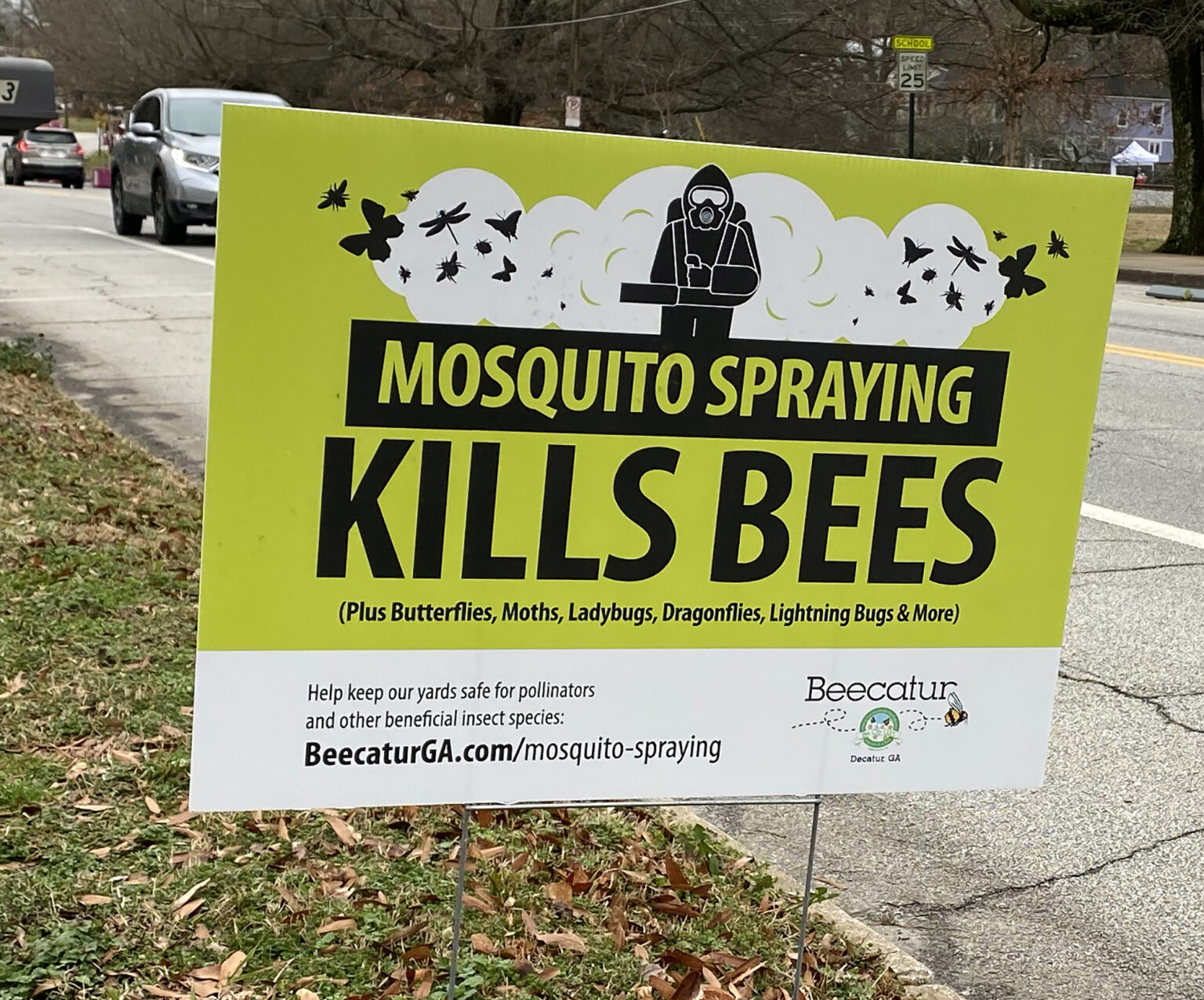Spring is quickly turning into summer, and with the warming temperatures comes the drone of mosquitoes in our parks and yards. You might also start seeing mosquito treatments being advertised by home pest control companies. Though disease concerns are important to consider, there are approximately 175 mosquito species in the United States, and only a few of them transmit disease. Even those species that can spread diseases are often not infected.
The trouble with mosquito pesticides
Unfortunately, the insecticide sprays used by pest control companies can be harmful to a wide variety of other insects. Some products carry misleading advertising, saying they are designed to act like the natural toxin found in chrysanthemum flowers. But, these products are still harmful to a number of beneficial insects. The other challenge with spraying is that mosquitos are highly mobile insects, and even if you kill adults, new ones will quickly move into your yard.

Signs created by the Bee City USA affiliate Decatur, GA. Decatur advocates for alternatives to mosquito spraying by individual homeowners efforts to protect pollinators. (Photo: Bee City USA – Decatur, GA.)
A better, safer way to reduce mosquitoes
Fortunately, there’s a much more effective way to reduce your itchy bites this summer and protect pollinators in your yard: focus on eliminating areas where mosquitoes breed.
The most effective way to do this? Eliminate standing water. Mosquitoes need water to reproduce – adults lay their eggs in still water, where they hatch and the larvae feed on microorganisms. After pupating, adults take flight and leave the water. This entire process takes only 8 to 10 days. Mosquitos only need one-inch of water to reproduce, so water that stands around for just over a week can lead to a population explosion.
Look around your yard for places where water might pool. Dump water from buckets and trash cans, and look for hidden flower pots that may have filled with rain over the winter and spring. Clogged gutters can be a surprise source of standing water for mosquitoes, so ensure they are free of debris. Finally, every few days, dump and refill water sources like pet bowls and bird baths to prevent any mosquito larvae from completing their life cycle.
Put nature (and household items) to work for mosquito prevention
For people with permanent water bodies, like ponds, a simple solution to avoid mosquitos is adding a fountain, waterfall, or small pump to keep the water moving, since mosquitoes can only reproduce in still water. If you use an open water pump, add protective screening, since they can pull dragonfly and damselfly nymphs in and kill them. Encouraging the populations of these insects and other predatory aquatic arthropods that eat mosquitoes (like diving beetles, water bugs, and copepods) can help control mosquito populations. The Xerces Society has information on managing backyard ponds for dragonflies and damselflies here.
Beyond getting rid of standing water, there are other preventative measures you can take to avoid being bitten. Protect yourself from bites by wearing long sleeves when mosquitoes are active and making sure your window screens are intact. Consider putting out a fan when sitting outdoors, as mosquitoes can’t fly in even light winds.

Mosquito sprays can harm beneficial insects, like this green lacewing larva busy eating an aphid. Contaminated flowers can still be toxic the next day for foraging bees, and butterfly larvae can be exposed even if spray happens early or late in the day. (Photo: Kevi Mace-Hill.)
Share the word to give mosquitoes the boot from your neighborhood
Since mosquitoes can easily fly across property lines, it’s worth encouraging your neighbors to remove standing water in their yards,. Check with your local vector control to see if they are eliminating standing water in your neighborhood, like storm drains and on public property. The earlier you can halt mosquito populations from establishing, the better!
You can also ask your local vector control district about their monitoring practices, and what type of community outreach they are engaging in.
Further reading:




